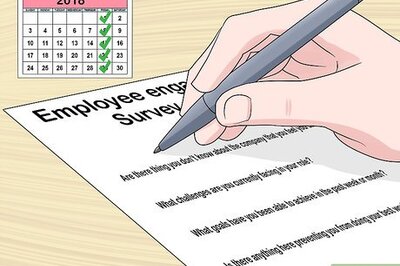
views
In this article, we will uncover the chemistry behind why Valentine’s Day seems tailor-made to boost libidos and sex life.
You’ve probably heard that romance tends to spike around Valentine’s Day. But, is there something deeper going on behind the scenes – perhaps even at a biochemical level? As it turns out, there are some fascinating scientific reasons why Cupid’s Arrow tends to hit its mark most accurately mid-February. From hormonal changes related to seasonal variations in light levels to psychological and cultural factors that lower inhibitions, research has uncovered why the two weeks surrounding February 14 have earned a steamy reputation.
The Science of Love: How Your Brain Chemistry Changes When You Fall In Love
Falling in love causes major changes in your brain chemistry. The potent cocktail of chemicals swirling in your brain creates an intoxicating rush of emotions. While the intensity will mellow over time, these hormones help to build long-term relationships through intimacy, trust and commitment.
- Dopamine and Euphoria: Dopamine is a neurotransmitter that activates the reward centre in your brain. When you’re with someone you care about, dopamine levels spike, giving you that rush of excitement and pleasure. Studies show dopamine levels are up to 25 percent higher in couples who have recently fallen in love.
- Low Serotonin and Rose-coloured Glasses: As dopamine goes up, serotonin levels decrease. Serotonin is the “calming” hormone, and lower levels are linked to increased obsession and impulsivity. This can make you see your new love through rose-coloured glasses, overlooking flaws and focusing on their good qualities. You may find yourself constantly thinking about them and craving to be together.
- Endorphins and Excitement: Your brain also pumps out endorphins, natural painkillers that act as sedatives. Endorphins give you that warm, fuzzy feeling and heightened sensations when you’re intimate with your partner. They’re also released during exciting and arousing activities, like a passionate Valentine’s Day date!
Oxytocin: The ‘love hormone’ and its role in sexual desire
Oxytocin is often called the ‘love hormone’ because it plays an important role in sexual arousal and pair bonding. Around Valentine’s Day, oxytocin levels naturally rise, which boosts libido and makes you feel more connected to your partner. Oxytocin is a hormone produced in the hypothalamus of the brain and released by the pituitary gland. It is released during intimate physical contact like hugging, kissing and sex. During foreplay and sex, oxytocin levels steadily climb, intensifying arousal and pleasure.
Oxytocin stimulates the release of nitric oxide, which dilates blood vessels in the genitals resulting in an erection in men and lubrication and swelling in women. After orgasm, oxytocin peaks, inducing feelings of deep relaxation, satiety and attachment. Cuddling, kissing and pillow talk after sex further boost oxytocin, forging an emotional connection and post-coital bliss.
Norepinephrine: The Neurochemical Behind Attraction and Arousal
Norepinephrine, an adrenaline-like hormone, is also released, triggering arousal and attraction. It quickens your pulse, makes you feel alert and focused, and intensifies those romantic feelings. Together, dopamine and norepinephrine are a potent combination on Valentine’s Day, fuelling passion and stimulating sexual desire.
Oestrogen and Testosterone: How Sex Hormones Spike Around Valentine’s Day
Around Valentine’s Day, you may notice an extra spark in your relationship. This isn’t just because of romantic cards or gifts – it’s actually due in part to chemistry. Oestrogen levels in women rise around ovulation, which often occurs around Valentine’s Day. This increase in oestrogen boosts libido and arousal in women. At the same time, testosterone levels also rise in both men and women around this time of year. Testosterone is responsible for sex drive and arousal in both sexes. The combination of increased oestrogen and testosterone means people of all genders tend to feel friskier in February.
Pheromones: The Subtle Chemical Signals That Spark Romance
Pheromones are odourless chemical signals that our bodies secrete through sweat and other bodily fluids. Although we can’t smell them, their scent is detected by the vomeronasal organ in our noses, which sends signals to the parts of our brain linked to attraction, emotion, and reproduction. For men, the key pheromone is androstenone, which gives off a musky scent that women tend to find attractive, especially around ovulation. For women, copulins are a major pheromone that increases men’s testosterone levels and arousal. On a date or romantic evening together, you’re in close proximity and picking up on each other’s pheromones, whether consciously or not.
Touching, hugging, kissing – all forms of affection on Valentine’s Day also boost pheromone production and exchange. Kissing exposes us to androstenol, a pheromone in men’s saliva that boosts arousal in women. The more time we spend engaged in these intimate acts with our partner, the more our bodies respond and crave each other.
Setting the mood
To set the mood for romance on Valentine’s Day and keep those neurochemicals flowing, engage in activities with your partner that you both find pleasurable and rewarding:
- Cook a delicious meal together: Preparing food releases dopamine.
- Watch a funny movie: Laughter also increases dopamine and norepinephrine.
- Give a small gift: Exchanging gifts causes a dopamine rush in both the giver and receiver.
- Massage each other: Physical touch stimulates the release of oxytocin, the ‘love hormone’, which enhances feelings of closeness and intimacy.
- Flirt and make eye contact: This signals attraction and arousal, triggering the release of dopamine and norepinephrine in both of you.
- Kiss passionately: Kissing floods your brain with dopamine, norepinephrine and oxytocin, fuelling desire and bringing you closer together.
- Have sex: This ultimate act of physical intimacy and pleasure results in surges of dopamine and oxytocin, strengthening your emotional and romantic bond.
So, this Valentine’s Day, don’t underestimate the power of chemistry. Your attraction to your special someone and boost in libido may feel like magic, but it’s really science. Pheromones and hormones are working behind the scenes, creating sparks that turn into flames of passion and desire. Enjoy this natural aphrodisiac effect – your body and your lover will thank you!

















Comments
0 comment